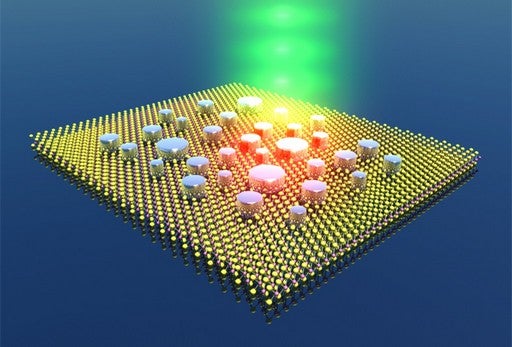A see-through metal
Goki EDA (Group Leader, Chemistry and Physics) () August 01, 20161 Aug 2016. NUS scientists discovered a way to enhance light transmission through a reflective metal surface by adding an atomically thin layer of semiconductor.
When light hits the surface of a metal, it is reflected back. This high reflectivity of light gives rise to the characteristic lustre of metal surfaces. An experimental research team led by Prof Goki EDA from the Departments of Chemistry and Physics and the Centre for Advanced 2D Materials in NUS found that metal nanoparticles partially lose their ability to reflect light and become semi-transparent when a layer of ultra-thin semiconductor is placed in their proximity. The research was in collaboration with researchers from Imperial College London, Kyushu University, and Kyoto University.
Metals are reflective because there are numerous electrons in the solid that prevent light frompropagating into the bulk of the solid. For the same reason, metal nanoparticles also strongly reflect (or scatter) light but at a particular wavelength (or color). In other words, metals are inherently good at blocking light. Common sense suggests that adding a layer of material above (or below) a metal would only further increase the chance of light being blocked because more material means better attenuation of light. However, the experiments by the NUS team showed an unexpected result. The researchers found that metal nanoparticles become more transparent and less reflective when placed on top of an ultrathin semiconductor layer. The team identified this peculiar effect as “electromagnetically induced transparency” where the two components of the system (metal nanoparticles and the semiconductor layer) respond collectively to light. The experiments demonstrated that the reflectivity of metal nanoparticles drops by as much as 25% in the presence of the semiconductor layer.
The researchers believe that it is possible to improve the transparency of the metal nanoparticles to nearly 100% at a specific wavelength of light. This will require precise engineering of the metal at the nano-scale and preparation of high quality semiconductor layer. Prof Eda envisions that metal-semiconductor hybrids could be a platform to develop devices for novel displays and optical communication technologies.

Figure shows a beam of light interacting with silver nanoparticles placed on top of an ultrathin semiconductor layer.
Reference
Zhao W, Wang S, Liu B, Verzhbitskiy I, Li S, Giustiniano F, Kozawa D, Loh KP, Matsuda K, Okamoto K, Oulton R F, Eda G. “Exciton–Plasmon Coupling and Electromagnetically Induced Transparency in Monolayer Semiconductors Hybridized with Ag Nanoparticles”. Advanced Materials, 28 (2016) 2709.


